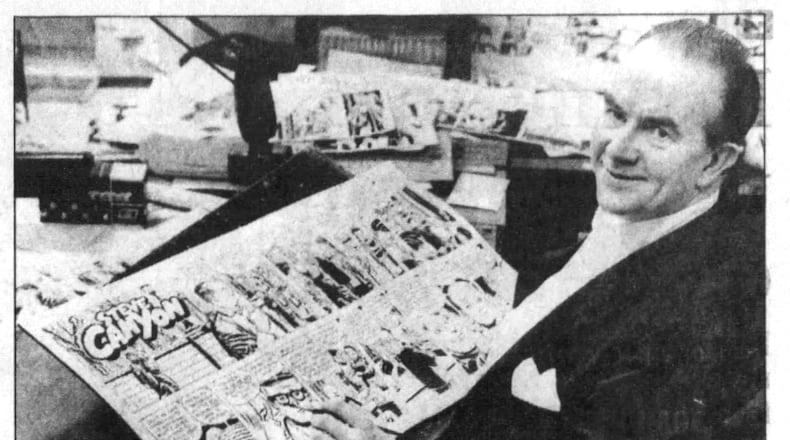By the end of his career, Caniff was one of the few surviving writer-artists left in the comic strip field.
Early life
Caniff’s father was printer and sometimes brought home paper scraps from the printing plant. By the light of a coal-oil lamp, he covered those scraps with drawings that were the beginning of his cartooning.
In the eighth grade in the 1920s, he took a correspondence course with the Landon mail-order cartoon school and volunteered drawing for the Boy Scout page in the Dayton Journal. As a result of his volunteer work, Caniff was offered a job as a office boy in the Journal art department.
In high school, Caniff drew a comic strip, Chic and Noodles, for The Stivers News.
After high school, Caniff went to Ohio State and secured a part-time job cartooning for The Columbus Dispatch.
Caniff once asked Billy Ireland, the editorial cartoonist at the Dispatch, if he should continue as an artist or switch to acting, which he also loved. Ireland’s advice was “Stick to your inkspots kid; actors don’t eat regularly.”
Caniff graduated from Ohio State in 1929.
Starting out
After graduation, Caniff married his high school sweetheart, Esther “Bunny” Parsons, and moved to New York.
There he started with the Associated Press, earning $60 per week.
After a few months, he began drawing Dickie Dare, an adventure strip about a boy in Robin Hood’s gang.
When the publisher of the New York Daily News saw Dickie Dare, he asked him to dream up a new comic strip.
The result in 1934 was Terry and the Pirates. He produced that comic until 1947.
Steve Canyon
Caniff began “Steve Canyon” in January 1947 after giving up “Terry and the Pirates.” His reason for dropping “Terry” was because he did not own the title outright. When he agreed to draw “Steve Canyon” for the Chicago Sun syndicate, it was with the agreement Caniff would own the title of the new strip.
Canyon was a dashing former Air Force captain in the Air Transport Command, who owned a company called Horizons Unlimited that was an air taxi service known for flying daring missions in every part of the globe.
Canyon operated the business and had help from other former military veterans who always stood ready to desert their own businesses or jobs anytime they received a call from Horizons Unlimited.
Canyon never had much money, but he seemed to have girlfriends at every destination.
“Steve Canyon” became a huge success and was carried in hundreds of newspapers for over four decades.
Caniff’s initial contract with the Chicago Sun syndicate for the strip was $100,000 a year for five years.
Honoring Stivers
Caniff was one of the most famous sons of Stivers High School.
Caniff returned to Stivers many times over the years, often to speak to an assembly or to art students.
Caniff, who was living in New York City, returned for an assembly event honoring Stivers' 60th anniversary.
One by one he drew his comic strip heroes that appeared daily in the Dayton Journal Herald. There was Steve Canyon, Happy Easter, Cheetah and Madame Lynx, the slinky villainess.
With each portrait came an art lesson on figure drawing.
Then, to the delight of the 900 students, Caniff drew a picture of the Stivers high school principal, Chester Gooding, whom the artist called “The Gregory Peck of Stivers High.”
Following the assembly, Caniff spoke to those students who were especially interested in art. He talked about his high school days, when he was a cheerleader and class president.
Caniff advised all the students to go to college and indicated that an artist’s life is arduous, but rewarding.
One student asked the artist what inspired him to write about the Air Force.
“I grew up in Dayton right along with the Air Force. Everything about it in those days was exciting and new. It just became part of me and it still is,” he said at the time.
Even though he and his wife lived in New York, his mother maintained a studio for him in Dayton, so he could keep up with his comics on visits home.
Respected artist
Caniff’s work was influential throughout the art world.
In 1939, Caniff was recognized by the Dayton Art Institute, where an exhibit of his works were hung during a month-long exhibition.
It was the first time an art museum recognized the work of a comic strip artist.
Later, his work was hung in the Metropolitan Museum of Art in New York, and a 1950 Newsweek cover story praised him as “the most widely aped artisan” who was “unexcelled in his line as an artist and storysmith.” In 1985 he was honored as “the Rembrandt of Comic Strips” at an exhibition at the Museum of Cartoon Art.
European filmmakers like Fellini and Resnais credited Caniff with inspiring their techniques. Film director Orson Wells is also known to have borrowed some of Caniff’s framing techniques for “Citizen Cane.”
His many awards are displayed in the Billy Ireland Cartoon Library and Museum at Ohio State.
Cartoonists pay last respects
Caniff died on April 3, 1988 at the age of 81.
Saturday, June 4, 1988 marked the last publishing of the Steve Canyon comic strip. The comic strip had enjoyed 41 years of worldwide popularity.
The last Steve Canyon was drawn by Pulitzer Prize-winning editorial cartoonist Bill Mauldin
. Many of Caniff’s cartoonist friends signed and dedicated this last strip in admiration.
The art shows Canyon joined by Mauldin’s classic soldier “Willie,” burying Caniff, but instead of marking the grave with a rifle as he would have done in World War II, an upright artist’s pen is poised, crowned with an Air Force helmet bearing Caniff’s name.
About the Author












